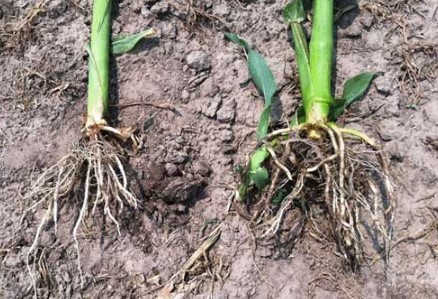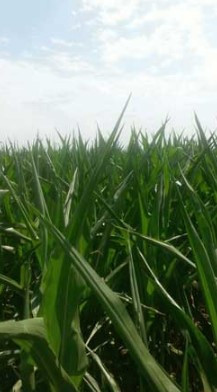By Ignacio Ciampitti & Mary Knapp
Since spring 2019 brought the wettest May on record for Kansas and cooler-than-normal temperatures, rains have been somewhat sporadic in recent weeks and warmer temperatures have finally arrived. Some of the dryland corn crop is experiencing a combination of heat and water stress (too much water). Moisture levels have varied from excessive in many areas early in the season to dry near the soil surface as corn is entering or already at the reproductive stages (Figure 1). Since the growing season is progressing very quickly, it is best to be prepared to take a close look for symptoms of potential drought stress.

Figure 1. Surface (2-inch, upper map) versus deep (20-inch, lower map) soil saturation levels. Maps by Kansas Mesonet.
Conducting field work -- including planting, tillage, or traffic in general -- after wet weather can cause soil compaction, and in particular sidewall compaction in the seed furrow. The worst cases of sidewall compaction are seen after a field has been planted when the soil was too wet, followed by a period of dry weather. If the soil stays moist, the roots are usually able to grow through the walls of the seed furrow. But if the soil gets dry, the roots can have a harder time growing through that seed furrow wall, and instead grow along the furrow, resulting in what is referred to as sidewall compaction (Figure 2). With corn, the plants might look fine for a while, but the symptoms of this problem will probably show up after the plants get to be several inches tall. Symptoms will look like drought stress, nutrient deficiency, or both.

Figure 2. Sidewall compaction in heavy clay soil. Photo by Stu Duncan, K-State Research and Extension.
Early season effects
Under stress conditions (for too much water or drought), shorter, less leafy plants are among the most visible symptoms. Plants may not be as green as usual if chlorophyll production is affected. The root systems will be smaller under these conditions since all below- and above-ground plant growth will be affected (Figure 3). Those symptoms are the outcome of plants that are less efficient in growing as photosynthesis is slowing down.

Figure 3. Effect of stress on root systems. On the left is a plant with a smaller root system and stalk diameter caused by stress. On the right is an unstressed corn plant, with greater root system, more nodal roots, and greater stalk diameter. Photo by Ignacio Ciampitti, K-State Research and Extension.
Critical period before and after silking
Note: It is difficult to think of drought stress when this season has been quite wet, but things could change fairly quickly and corn is moving quite fast in many areas of the state. At what stage of growth is corn most sensitive to moisture stress? To answer the question, we need to know the most important growth stages for grain determination. The final number of kernels for corn is determined around the pollination period (2 weeks before and 2 weeks after flowering). Thus, corn is extremely sensitive to stress during that period. Stress directly affects the final number of kernels through different processes, such as:
1. Potential delays in silking (asynchrony between the development of male and female reproductive parts). This happens when the tassel is shedding pollen but the ear is not yet receptive (silks are not yet out of the husk).
2. Potential reductions in ear size (smaller ears with less physical space for bearing grains).
3. Shorter time for pollen receptivity. This occurs when the silks dry out very fast under warm temperatures, impeding a successful pollination.
4. Pollination is concentrated in just a few days. In general, pollination takes place earlier and with a short duration under drought stress. High temperatures can also potentially impact pollen viability.
5. Even when pollination is effective, kernel abortion or cessation can occur right after flowering, in the blister and milk stages, if drought stress continues.
Under extreme moisture and heat stresses, plants may be barren, with no ears being formed at all, if conditions were severe well before pollination time. Overall reductions in potential yield can be expected whether the stress occurs early (10-leaf to 15-leaf stages) or late (dough and dent stages) in the crop growing season.

Figure 4. Leaf rolling in corn under stress during early reproductive stages. Photos by Ignacio Ciampitti, K-State Research and Extension.
Management practices and other factors
From a management practice perspective, situations that tend to make corn more susceptible to stress include high plant densities, narrow row spacing, and excessive applications of fertilizer or manure. Planting conditions, as highlighted above, are one of the key factors potentially impacting this year root growth (due to compaction) and therefore, this could potentially exacerbate stress symptoms.
In summary, scout your acres for plant stress symptoms. The impacts of the stress on grain yield can be known with more precision right around flowering time.
Source: ksu.edu